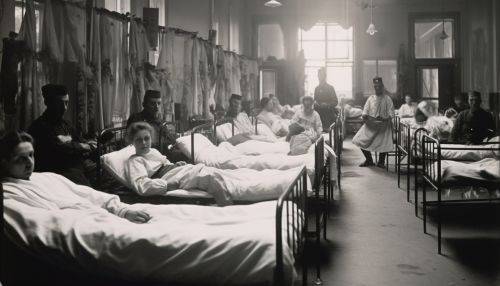Spanish flu
Overview
The Spanish flu, also known as the 1918 influenza pandemic, was an exceptionally deadly global influenza pandemic caused by the H1N1 influenza A virus. The earliest cases were observed in March 1918, with the disease reaching pandemic levels in the months that followed. Lasting until 1920, it infected an estimated 500 million people, about a third of the world's population at the time, and resulted in the deaths of 20 to 50 million victims.
Origins
The exact origin of the Spanish flu remains uncertain. However, it is believed to have originated from an avian influenza virus. The disease was first identified in military personnel in spring 1918 in the United States. It was wrongly named the "Spanish flu" as Spain, a neutral country during World War I, did not censor news about the flu outbreak, leading to a misconception that Spain was the most affected country.
Epidemiology
The Spanish flu was characterized by a high infection rate and an unusually high mortality rate. It is estimated that about one third of the world's population was infected by the virus. The disease spread rapidly due to the crowded conditions of the military camps and hospitals during World War I. Unlike typical influenza viruses, which tend to be most deadly to the very young, the elderly, and the immunocompromised, the Spanish flu had a high mortality rate among healthy adults between the ages of 20 and 40.


Symptoms and Complications
The symptoms of the Spanish flu were similar to those of other strains of human influenza, including fever, fatigue, and respiratory symptoms. However, the disease could rapidly progress to severe complications, including pneumonia, acute respiratory distress syndrome, and death. Some patients also developed neurological symptoms, such as confusion and somnolence, which were likely due to the direct effects of the virus on the central nervous system.
Treatment and Prevention
At the time of the Spanish flu pandemic, there were no effective vaccines or antiviral drugs to treat influenza. Prevention efforts were limited to isolation, quarantine, good personal hygiene, use of disinfectants, and limitations on public gatherings. The development of a vaccine for the Spanish flu was hindered by a lack of understanding of the disease and the absence of modern diagnostic tools.
Impact
The Spanish flu had a profound impact on global society. It caused significant social disruption and economic loss. The high mortality rate, particularly among young adults, led to a significant demographic shift. The pandemic also had long-term effects on public health infrastructure and policy, leading to improvements in disease surveillance and response.
Legacy
The Spanish flu pandemic is considered one of the deadliest natural disasters in human history. It has been the subject of extensive scientific study in the fields of epidemiology, virology, and public health. The lessons learned from the Spanish flu have informed the global response to subsequent influenza pandemics and other infectious disease outbreaks.
